How To Use Ranger Beads. (With Step by Step Pictures.)
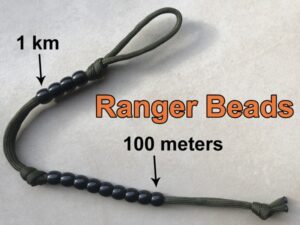
Pace counting beads, also called Ranger beads are a way to keep track of the distance traveled.
They are useful when navigating for backpackers, military, army cadets, scouts, and another skill to learn for bushcraft and survival use.
Below is more specific detail on how to use Ranger beads. But for a rough picture, you know how many steps it takes to cover 100 meters. (Or yards.) You count your paces. Once you have reached the steps / distance, you slide a bead down. This then indicates how far you have traveled.
About the pacing beads.
The Ranger beads have some limitations and don’t give an exact distance, but are a useful tool.
It is more accurate than a guesstimate of distance traveled. But obviously not as accurate as a GPS. (Global Positioning System.)
The beads should be used with other navigational tools like a map and compass. Click on How To Use A Compass (Step by step with practical examples and pictures.) for more information.
The value of the beads, depending on personal preference could be any amount. Like imperial or metric units, such as 100 yards, or 100 meters.
Ranger beads normally have thirteen beads on a length of cordage. This could be any number though.
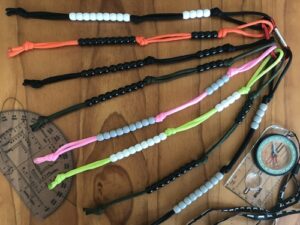
The pace beads are generally comprised of two sections. Four beads on top and nine beads below.
Each top bead can represent a 1000 meters. (1 km, or .62 mile.) Or it can represent 1 mile.
The bottom bead normally represents 100 meters. (About 328 feet.) Or can indicate yards.
A bead might even represent a set number of steps, such as 50 steps or 100 steps. Instead of a set distance.
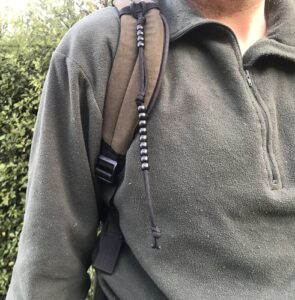
How to use Ranger beads in the field.
Step 1. Measure one hundred meters. (Or use yards.)
Measure out 100 meters.
Count how many steps it takes to cover that 100 meters. As an example it might be 65 steps to cover 100 m.
Only count every time the right foot hits the ground you count a step. (Or left if you prefer.)
You might work out steps / distance for flat terrain, uphill and downhill. The average them all out and write the number down.
Step 2. Count the steps and move the beads.
Once we know how many steps equals 100m, we can begin navigating.
When starting out on the first navigational leg of the journey, count the steps.
Once you have hit the amount of steps it takes to get 100 m, (E.g. 65 steps.) slide the bottom section bead down the cordage.
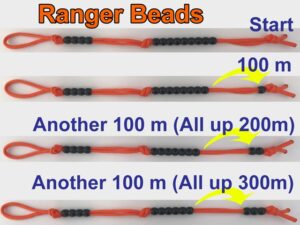
You then start counting from scratch again. When another 100 m (E.g. 65 steps.) is reached, move another bottom section bead down the cordage.
You would now have two beads slid down. This would represent 200 meters traveled.
Repeat the process so all the lower section 9 beads will be down. This would mean 900 meters has been traveled.
Once another hundred meters (E.g. 65 steps counted.) has been reached, slide the top bead down. This would represent you have travelled 1000m or 1km. (.62 mile.)
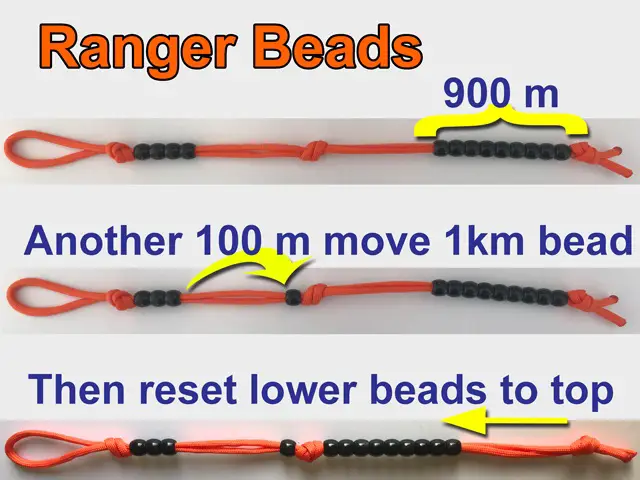
You then reset the bottom beads by sliding them up to the top again.
Repeat the counting and sliding the top and bottom beads until you have reached four or five kilometers.
Reset all beads and repeat for more distance.
Finer points on how to use the pace counting beads.
For measuring 100 meters initially, you could use a rangefinder, paper map, GPS, phone app maps / location, vehicle odometer, measuring wheel, long measuring tape.
Ideally measure your steps around three times or so and average it out.
If you hike a lot of hills and mountains, work out your paces for uphill and downhill.
You might measure and count paces on flat ground three times, average it out. Count / measure up hill and down three times each. Then average them all out and you know your rough pace count for different terrain.
Carrying a heavy backpack compared to no load will affect the length of stride. Using hiking boots versus normal shoes will also make a difference.
Generally test with what you would be wearing, carrying and in the terrain traveling, if possible.
Negatives of the pacing beads.
A lot of variables will affect the accuracy of the stride / step distance and hence then the real distance traveled.
Dense vegetation underfoot, sticks, long grass, snow, mud, sand, rocks will affect your pace count / distance.
Going around trees, and natural drift to the left or right will also affect the linear distance actually traveled.
Weather will also affect your steps. As an example walking head first into strong winds or rain.
Generally at night time your paces will be shorter as visibility won’t be as good and you are more cautious stepping. Ranger beads are valuable at night though, as you can easily lose track of visual landmarks and distance.
Pace counting bead ideas and tips.
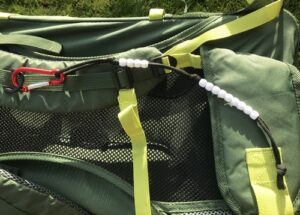
Use a larks head knot to attach the loop to a backpack loop or a carabiner.
Ranger beads can also be put on a compass lanyard or belt.
For navigating when hunting. – Stopping with your right foot slightly behind is useful if you are hunting with a gun or bow. As when you are stopped you are in a better position to shoot with the right foot slightly back. (Assuming you are right handed.) Lead off with your left foot and then count when the right foot hits the ground. (The initial first step won’t be as long or accurate as a normal step, but might give you an opportunity when hunting.)
Opposite count. – Once you have achieved the maximum distance the beads can indicate and they are all slid down, instead of re-setting and sliding the beads up again, some people will leave the beads down. They then slide them up to count up and vise-versa. This can get confusing though, if no attention is paid to which way the beads are getting moved though.
If you don’t have pacing beads, you can use pebbles. Transfer from one pocket to the other to count when you have reached the steps / distance required.
Another idea is to tie a knot (loose) in some cordage for steps / distance. When you get so many paces, you tie another knot.
Summary – How To Use Ranger Beads.
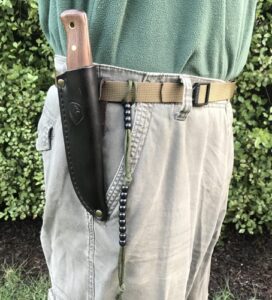
Pace counting beads have some drawbacks, but are a useful way to keep track of distances traveled when navigating.
Use the beads with a compass, map and natural navigation skills.
Knowing how to use Ranger beads gives us another tool to apply in the woods.
